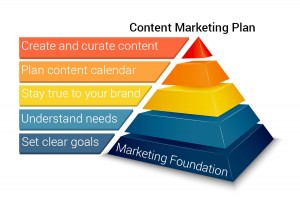
Create a solid content marketing foundation
All construction must begin with a solid foundation otherwise you risk building a structure that requires constant maintenance and repair. Effective content marketing is no different. Your content strategy must be architected and built as carefully and with as much care as the foundation of a building.
But with small businesses under pressure to churn out interesting content in order to attract attention and drive inbound leads, many don’t take the time to build the foundation that guides the content creation process in order to contribute to a successful return on investment.
Before you begin spending time and effort writing content, take a moment to be sure your content marketing foundation is solid.
Set clear goals for your content
What do you want to achieve with content marketing? Do you want to generate new leads, build rapport with your audience or increase customer loyalty and retention? Do you want to position your company as a thought leader? The type of content you need for each of these goals will be different.
- To build rapport, your content should be freely available and consumable without strings. Examples of this type of content would include blog posts and posting on your social profiles.
- To attract new, qualified leads, content can be provided in return for their email address. Examples of this type of content include white papers, templates, ebooks, webinar replay and other content that is downloaded once the person signs up for your email list.
- To increase customer loyalty and retention, content needs to continue to solve problems. Send newsletters, personalized emails and other content that helps customers use your products and services more effectively.
Understand the information needs of your audience
The need to deeply understand your target audience is nothing new in marketing. By focusing on a well-defined target, your messages are crisp and your marketing becomes more effective. If you are investing time and money into content marketing and want to achieve your desired results, you must understand what your ideal client needs that will help them make a purchase decision. Then you can deliver content that aligns with those needs and makes your business the go to source for reliable information.
Once you are armed with this information, then you can determine which channels will best reach them. Promoting your content to your target audience is important to the success of your content marketing strategy.
- To build rapport, share your content on social sites.
- To attract qualified leads, share your content via promoted posts, sending interested parties to your website landing page to sign up.
- To increase customer loyalty and retention, create help videos, whitepapers and other content types that enable them to get answers quickly and easily.
Offer content that provides advice, education and useful solutions freely and without a sales pitch in order to build trust and authority with your prospects and customers. Relationships built on trust are more likely to move beyond free advice into a profitable relationship for your business.
Stay true to your brand
Your brand is the image you portray to the world and is one of your company’s most valuable assets. It communicates your corporate personality and shapes the internal and external clients’ perceptions of who you are as well as the expectations and promises you extend to your customers in terms of quality, service, reliability and trustworthiness. A strong brand helps the audience differentiate you from your competitors and can positively influence their purchasing decisions, directly impacting your profitability.
When you create and share content, it creates an awareness for your brand and influences your brand reputation. It is important that your content consistently reflects your brand image.
Plan your content calendar
We all have good intentions when it comes to creating content. However, one of the most often cited content marketing challenges is creating enough (targeted) content. When businesses feel pressure to supply more content than their resources can adequately provide, quality suffers.
Planning a content editorial calendar helps you create a framework for what needs to be produced, in what format and when. Your editorial calendar enables you to identify content by type of media – blog posts, webcasts, presentations, videos, testimonials, ebooks, white papers – along with target date, who is responsible and the focused keyword that you want this content to be optimized around. Keep this information in your editorial calendar and you are ready to track and manage your content creation process.
Curate content that augments your original content
Creating content takes time and effort, but producing original, relevant content with an effective call to action is the most important aspect of your content marketing strategy. But it isn’t the case that you must provide all original content.
Content curation is sharing resources about your particular topic that interest your followers and connections. By curating content, you let people know you are keeping up with current trends and information about your area of expertise and becoming a centralized resource for helping your readers and followers find information that they may not find on their own.
Build Upon the Foundation
Now you are ready to begin your content marketing efforts. Building a solid foundation first and planning your content around marketing goals will enable you to produce the right content that consistently projects your brand and serves your readers the information they need.
Have you developed a solid marketing foundation to guide your content marketing for your business?
Article source: http://masterful-marketing.com/content-marketing-requires-a-solid-marketing-foundation/
